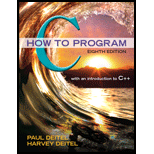
(Write C++ Statements) Write a statement for each of the following:
- Print integer 40000 left justified in a 15-digit field.
- Read a string into character array variable state.
- Print 200 with and without a sign.
- Print the decimal value 100 in hexadecimal form preceded by 0x.
- Read characters into array charArray until the character ‘p’ is encountered, up to a limit of 10 characters (including the terminating null character). Extract the delimiter from the input stream, and discard it.
- Print 1.234 in a 9-digit field with preceding zeros.
a.
To print integer 4000 left justified in a 15-digit field.
Explanation of Solution
The function setw() is used in C++ to adjust the field width for output.
intleftalign=4000;
cout<<setw(15)<<leftalign;
b.
To read a string into character array variable state.
Explanation of Solution
Following statement will read as string into character array variable state.
cin>>state;
c.
To print 200 with and without a sign.
Explanation of Solution
Following statement will print the number 200 with sign
cout<< “+200”;
Following statement will print the number 200 without sign
cout<< “200”;
d.
To print the decimal value 100 in hexadecimal form preceded by 0x.
Explanation of Solution
Following set of statement will print the decimal value 100 as specified.
cout<<”Print the value decimal value 100 in hexadecimal format”;
inttoHex = 100;
cout<<”The decimal number 100 converted to hexadecimal =”;
e.
To read the characters into array charArray until the character ‘p’ is encountered, upto a limit of 10 characters (including the terminating null character). To extract the delimiter from the input stream and discard it.
Explanation of Solution
char array[10];
for( int i=0;i<10; i++)
{
if(array[i]!=‘p’)
{
cout<<array[i];
}
else break;
}
array[--i] = “”;
f.
To print 1.234 in a 9-digit field with preceding zeros.
Explanation of Solution
Following statement will print 1.234 with 9 digit field with preceding zeros.
cout<<setfill('0')<<setw(9)<<1.234;
Want to see more full solutions like this?
Chapter 21 Solutions
C How to Program (8th Edition)
Additional Engineering Textbook Solutions
Concepts Of Programming Languages
Degarmo's Materials And Processes In Manufacturing
Modern Database Management
Starting Out with Python (4th Edition)
Starting Out with Java: From Control Structures through Data Structures (4th Edition) (What's New in Computer Science)
Mechanics of Materials (10th Edition)
- what is a feature in the Windows Server Security Compliance Toolkit, thank you.arrow_forwardYou will write a program that allows the user to keep track of college locations and details about each location. To begin you will create a College python class that keeps track of the csollege's unique id number, name, address, phone number, maximum students, and average tuition cost. Once you have built the College class, you will write a program that stores College objects in a dictionary while using the College's unique id number as the key. The program should display a menu in this order that lets the user: 1) Add a new College 2) Look up a College 4) Delete an existing College 5) Change an existing College's name, address, phone number, maximum guests, and average tuition cost. 6) Exit the programarrow_forwardShow all the workarrow_forward
- Show all the workarrow_forward[5 marks] Give a recursive definition for the language anb2n where n = 1, 2, 3, ... over the alphabet Ó={a, b}. 2) [12 marks] Consider the following languages over the alphabet ={a ,b}, (i) The language of all words that begin and end an a (ii) The language where every a in a word is immediately followed by at least one b. (a) Express each as a Regular Expression (b) Draw an FA for each language (c) For Language (i), draw a TG using at most 3 states (d) For Language (ii), construct a CFG.arrow_forwardQuestion 1 Generate a random sample of standard lognormal data (rlnorm()) for sample size n = 100. Construct histogram estimates of density for this sample using Sturges’ Rule, Scott’s Normal Reference Rule, and the FD Rule. Question 2 Construct a frequency polygon density estimate for the sample in Question 1, using bin width determined by Sturges’ Rule.arrow_forward
- Generate a random sample of standard lognormal data (rlnorm()) for sample size n = 100. Construct histogram estimates of density for this sample using Sturges’ Rule, Scott’s Normal Reference Rule, and the FD Rule.arrow_forwardCan I get help with this case please, thank youarrow_forwardI need help to solve the following, thank youarrow_forward
 C++ for Engineers and ScientistsComputer ScienceISBN:9781133187844Author:Bronson, Gary J.Publisher:Course Technology Ptr
C++ for Engineers and ScientistsComputer ScienceISBN:9781133187844Author:Bronson, Gary J.Publisher:Course Technology Ptr Microsoft Visual C#Computer ScienceISBN:9781337102100Author:Joyce, Farrell.Publisher:Cengage Learning,
Microsoft Visual C#Computer ScienceISBN:9781337102100Author:Joyce, Farrell.Publisher:Cengage Learning, C++ Programming: From Problem Analysis to Program...Computer ScienceISBN:9781337102087Author:D. S. MalikPublisher:Cengage Learning
C++ Programming: From Problem Analysis to Program...Computer ScienceISBN:9781337102087Author:D. S. MalikPublisher:Cengage Learning Programming with Microsoft Visual Basic 2017Computer ScienceISBN:9781337102124Author:Diane ZakPublisher:Cengage Learning
Programming with Microsoft Visual Basic 2017Computer ScienceISBN:9781337102124Author:Diane ZakPublisher:Cengage Learning EBK JAVA PROGRAMMINGComputer ScienceISBN:9781337671385Author:FARRELLPublisher:CENGAGE LEARNING - CONSIGNMENTProgramming Logic & Design ComprehensiveComputer ScienceISBN:9781337669405Author:FARRELLPublisher:Cengage
EBK JAVA PROGRAMMINGComputer ScienceISBN:9781337671385Author:FARRELLPublisher:CENGAGE LEARNING - CONSIGNMENTProgramming Logic & Design ComprehensiveComputer ScienceISBN:9781337669405Author:FARRELLPublisher:Cengage





